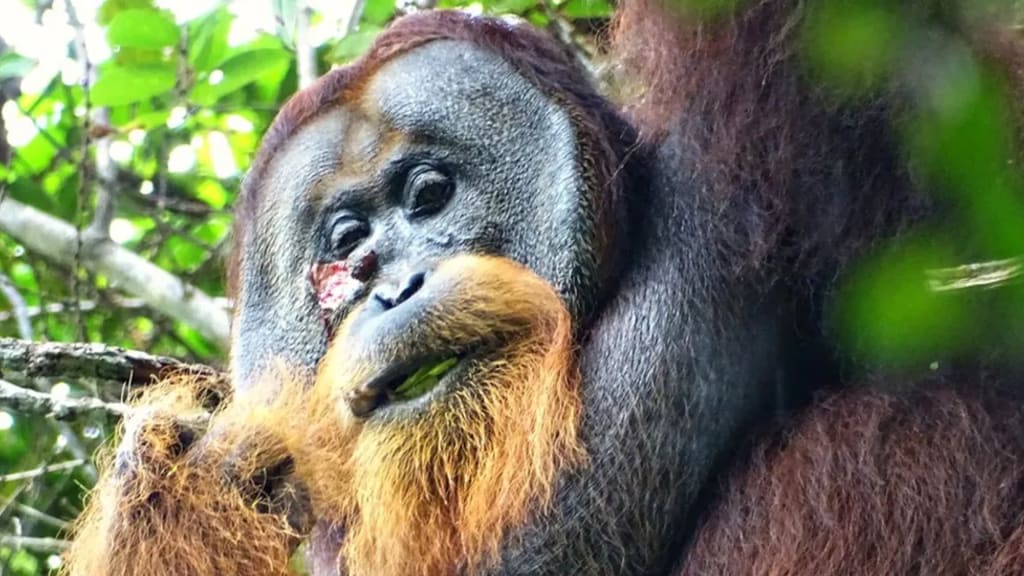Content warning
This story may contain sensitive material or discuss topics that some readers may find distressing. Reader discretion is advised. The views and opinions expressed in this story are those of the author and do not necessarily reflect the official policy or position of Vocal.
Wounded orangutan seen using plant as medicine?
Wounded orangutan seen using plant as medicine

A Sumatran orangutan in Indonesia has self-medicated using a paste made from plants to heal a large wound on his cheek, say scientists.
It is the first time a creature in the wild has been recorded treating an injury with a medicinal plant.
After researchers saw Rakus applying the plant poultice to his face, the wound closed up and healed in a month.
Scientists say the behaviour could come from a common ancestor shared by humans and great apes.
"They are our closest relatives and this again points towards the similarities we share with them. We are more similar than we are different," said biologist Dr Isabella Laumer at the Max Planck institute in Germany and lead author of the research.
A research team in the Gunung Leuser National Park, Indonesia spotted Rakus with a large wound on his cheek in June 2022.
They believe he was injured fighting with rival male orangutans because he made loud cries called "long calls" in the days before they saw the wound.
The team then saw Rakus chewing the stem and leaves of plant called Akar Kuning - an anti-inflammatory and anti-bacterial plant that is also used locally to treat malaria and diabetes.
He repeatedly applied the liquid onto his cheek for seven minutes. Rakus then smeared the chewed leaves onto his wound until it was fully covered. He continued to feed on the plant for over 30 minutes.
The paste and leaves then appear to have done their magic - the researchers saw no sign of infection and the wound closed within five days.
After a month, Rakus was fully healed.
The scientists concluded that Rakus knew he was applying medicine because orangutans very rarely eat this particular plant and because of the length of the treatment.
"He repeatedly applied the paste, and he later also applied more solid plant matter. The entire process lasted really a considerable amount of time - that's why we think that he intentionally applied it," explains Dr Laumer.
The researchers also saw Rakus resting for much longer than usual - more than half of the day - suggesting he was trying to recuperate after the injury.
Scientists were already aware that great apes used medicine to try to heal themselves.
In the 1960s biologist Jane Goodall saw whole leaves in the faeces of chimpanzees, and others documented seeing great apes swallowing leaves with medicinal properties.
But they had never seen a wild animal applying a plant to a wound.
Dr Laumer says it is possible that it was the first time Rakus had done this type of treatment.
"It could be that he accidentally touched his wound with his finger that had the plant on it. And then because the plant has quite potent pain relieving substances he might have felt immediate pain relief, which made him apply it again and again," she says.
Or he could have learned the method from watching other orangutans in his group.
The researchers will now be closely watching other orangutans to see if they can spot the same medical skills that Rakus showed.
"I think in the next few years we will discover even more behaviours and more abilities that are very human-like," she suggests.
The research is published in the scientific journal Scientific Reports.
#Plant #Medicine #orangutan
Thanks 👍 All friends
"It could be that he accidentally touched his wound with his finger that had the plant on it. And then because the plant has quite potent pain relieving substances he might have felt immediate pain relief, which made him apply it again and again," she says.
Or he could have learned the method from watching other orangutans in his group.
The researchers will now be closely watching other orangutans to see if they can spot the same medical skills that Rakus showed.
"I think in the next few years we will discover even more behaviours and more abilities that are very human-like," she suggests.
The research is published in the scientific journal Scientific Reports.
About the Creator
Angel Malaika
hi i am angel malaika🤞 i love to write especially about technology i love to write in class i am 18 yrs old i have failed in school everyone please pray for me and subscribe my account and my posts friends Thank you all for sharing ❤️❣️
Enjoyed the story? Support the Creator.
Subscribe for free to receive all their stories in your feed. You could also pledge your support or give them a one-off tip, letting them know you appreciate their work.






Comments (2)
Interesting and delicious content. Keep posting more
Please 🙏 Subscribe 🥺🙏